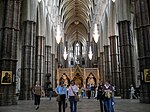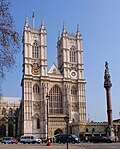Little Dean's Yard

Little Dean's Yard, known to Westminster School just as Yard, is a private gated yard at the heart of the school, within the precincts of the ancient monastery of Westminster. It is a secluded enclave on the original Thorney Island, now shared between Westminster Abbey and the Palace of Westminster, and unsuspected by millions of Londoners who pass nearby between Westminster and Victoria. To the East is College Garden (which refers to the collegiate body of Westminster Abbey, and not only to the school), the oldest cultivated garden in England, and formerly the infirmary garden of the monastery. Beyond is the Victoria Tower of the Palace of Westminster, which towers over the Yard. The chimes of Big Ben mark every quarter of every hour. The entrance to the great School, formerly the monks' reredorter, is a stone arch designed by Lord Burlington. A stone path marks the original way, before the rest of Yard was paved, to the low stone tunnel under another row of monastic buildings which leads to Dean's Yard, cars, and the outside world. On the North side of Yard is Ashburnham House, built by Inigo Jones or his pupil John Webb, on the site of the mediaeval Prior's House, parts of which can still be seen. The bricks show the signs of impatient schoolchildren drilling away with coins while awaiting the opening of the school tuck-shop. A wide archway leads through the Dark Cloister to the Abbey, and the school gym. On the South, three Georgian houses accommodate Rigaud's and Grant's houses, and that of the Master of the Queen's Scholars. College to the East was designed by Burlington, with Christopher Wren's approval after his own design was rejected.
Excerpt from the Wikipedia article Little Dean's Yard (License: CC BY-SA 3.0, Authors, Images).Little Dean's Yard
Way of the Monks, London Millbank
Geographical coordinates (GPS) Address Nearby Places Show on map
Geographical coordinates (GPS)
| Latitude | Longitude |
|---|---|
| N 51.4984 ° | E -0.1279 ° |
Address
Little Dean's Yard
Way of the Monks
SW1P 3PJ London, Millbank
England, United Kingdom
Open on Google Maps







